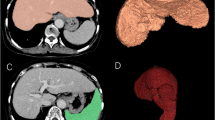Abstract
99mTc-galactosyl human serum albumin (99mTc-GSA) scintigraphy is a new method for evaluating liver function. This scintigraphy is useful for evaluating the severity of liver diseases. The indices evaluating hepatic function include the receptor index (LHL15) and the index of blood clearance (HH15). These indices are calculated on the basis of the regions of interest (ROIs) for both whole liver and heart, and are susceptible to the ROIs over heart and liver. At present, there is no standard method for determining ROIs. We attempted to establish a standard method which shall not be subject to inter and/or intra operator variation. A computer program to determine heart and liver ROIs semi-automatically was developed. Ten patients (12 instances) were studied with99mTc-GSA, and HH15 and LHL15 were calculated on the basis of the ROIs obtained manually and semiautomatically by 3 different operators independently. Blood sampling and gamma-counting yielded blood clearance data. The ICG R15 was compared with each index in 34 patients. The time needed for ROI determination was reduced from 2–3 minutes for the manual method to 0.5–0.8 minutes for the semi-automatic method. The % coefficients of variation (% CVs) of HH15 and LHL15 were improved in the order manual-inter observer (M-inter), manual-intra observer (M-intra) and semiautomated-inter observer (SA-inter); % CVs of HH15 were 2.26% for M-inter, 1.55% for M-intra and 0.07% for SA-inter, and % CVs of LHL15 were 2.29% for M-inter, 0.46% for M-intra and 0.07% for SA-inter. The correlation of HH15 and LHL15 among M-inter, M-intra and SA-inter was good. Comparison of indices obtained by manual and semi-automatic methods with blood clearance data obtained by blood sampling and gamma-counting showed good correlations and no significant differences. The comparison with ICG R15 showed that HH15 and LHL15 by the semi-automated method gave better correlation that that by the manual method. A newly developed semi-automated method improved data processing time and deviation of indices in99mTc-GSA studies. This method should substitute for manual ROI determination.
Similar content being viewed by others
References
Stadalink RC, Vera DR, Woodle ES, Trudeau WL, Porter BA, Ward RE, et al. Technetium-99m-NGA functional hepatic imaging: preliminary clinical experience.J Nucl Med 26: 1233–1242, 1985.
Vera DR, Stadalnik RC, Trudeau WL, Scheibe PO, Krohn KA. Measurement of receptor concentration and forwardbinding rate constant via radiopharmacolinetic modeling of technetium-99m galactosyl-neoglycoalbumin.J Nucl Med 32: 1169–1176, 1991.
Kudo M, Todo A, Ikekubo K, Hino M. Receptor index via hepatic asialoglycoprotein receptor imaging: correlation with chronic hepatocellular damage.Am J Gastroenterol 87: 865–870, 1992.
Shiomi S, Kuroki T, Kuriyama M, Takeda T, Nishiguchi S, Nakajima S, et al. Evaluation of fluminant hepatic failure by scintigraphy with technetium-99m-GSA.J Nucl Med 38: 79–82, 1997.
Itano S, Sata M, Kumashiro R, Hirai K, Tanikawa K. Usefulness of technetium-99m-galactosyl human serum albumin liver scintigraphy for severity of alcoholic hepatitis.Alcohol Clin Exp Res 20 (1 suppl): 86A-90A, 1996.
Kwon AH, Ha-Kawa SK, Uetsuji S, Kamiyama Y, Tanaka Y. Use of technetium 99m diethylenetriamine-pentaacetic acid-galactosyl-human serum albumin liver scintigraphy in the evaluation of preoperative and postoperative hepatic function reserve for hepatectomy.Surgery 117: 429–434, 1995.
Morell AG, Irvine RA, Stemlieb I, Scheinberg IH, Ashwell G. Physical and chemical studies on ceruloplasmin. V. Metabolic studies on sialic acid-free ceruloplasminin vivo.J Biol Chem 243: 155–159, 1968.
Ashwell G, Steer CJ. Hepatic recognition and catabolism of serum glycoprotein.JAMA 246: 2358–2364, 1981.
Sawamura T, Kawasato S, Shiozaki Y, Sameshima Y, Nakada H, Tashiro Y. Decrease of a hepatic binding protein specific for asialoglycoproteins with accumulation of serum asialoglycoproteins in galactosamine treated rats.Gastroenterology 81: 527–533, 1981.
Kwon AH, Ha-Kawa SK, Uetsuji S, Inoue T, Matsui Y, Kamiyama Y. Preoperative determination of surgical procedure for hepatectomy using technetium-99m-galactosyl human serum albumin (99mTc-GSA) liver scintigraphy.Hepatology 25: 426–429, 1997.
Hashimoto J, Ishibashi A, Kajitani T, Kurihara T, Fukamizu Y, Kitahara T, et al. Quantitative evaluation of liver function with99mTc-GSA scintigraphy using extraction index.KAKU IGAKU (Jpn. J Nucl Med) 31: 1093–1100, 1994.
Shinohara H, Hasebe S, Kuniyasu Y, et al. A study on liver function indices LU3 and LU 15 with99mTc-GSA.Radioisotopes 43: 346–349, 1994.
Author information
Authors and Affiliations
Corresponding author
Rights and permissions
About this article
Cite this article
Koizumi, M., Yamada, Y., Nomura, E. et al. An easy and reproducible semi-automatic method for the evaluation of99mTc-galactosyl human serum albumin. Ann Nucl Med 11, 345–348 (1997). https://doi.org/10.1007/BF03165305
Received:
Accepted:
Issue Date:
DOI: https://doi.org/10.1007/BF03165305




